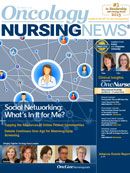Helping Your Patients to Navigate Cancer Resources Online
We have arrived at a time when even the stubborn, unwilling, and elderly now use the Internet.
Lisa Schulmeister, RN, MN, APRN-BC, OCN®, FAAN
Editor-in-Chief OncLive Nursing
Oncology Nursing Consultant, Adjunct Assistant Professor of Nursing Louisiana State Health Sciences Center in New Orleans, Louisiana
We have arrived at a time when even the stubborn, unwilling, and elderly now use the Internet. Data from the Pew Internet and American Life Project suggest that 81% of US adults regularly use the internet and 59% have searched online for health information in the past year. And 63% of adult cell phone owners now use their phones to go online—a figure that has doubled since Pew first started tracking Internet usage on cell phones in 2009. In addition, 34% of these cell phone Internet users reported that they mostly go online using their cell phone. That means that 21% of all adult cell owners now do most of their online searching using a mobile device and not a desktop or laptop computer.
An online search of “cancer treatment” (which is likely a topic that our patients search about) yielded more than 4.2 million results—on YouTube alone. Searching on Google produced 226 million results. Yes, the term “cancer treatment” is very broad, but these searches demonstrate the vast amount of information available to our patients.
The information is sometimes not all that good. A number of websites and YouTube videos purport that sodium bicarbonate, soursop juice, and “natural remedies” are effective cancer treatments. Patients may find the 2-minute “Anatomy of a Cancer Treatment Scam” video to be helpful in sorting this out; it’s available on the National Cancer Institute’s website (http://goo.gl/QVMWvJ), and posted on YouTube. Fortunately, there are many reputable sites that offer reliable, evidence-based information.
There’s lots to search for—and find. First, let’s start with an oncology practice’s or cancer center’s website. Aside from posting the usual information, such as location and services provided, these websites are increasingly being used to provide patient information and support. Generally, these sites keep building on prior material and get larger and larger, while patients increasingly use smaller and smaller devices (think cell phones) to access the information. So keep this in mind when adding things to your practice’s or cancer center’s website.
Some of the many examples of provider-driven websites is MD Anderson’s Cancerwise website (www2.mdanderson. org/cancerwise). Topics posted on the website range from words of wisdom from patients to nutrition tips for caregivers (yes, you read that correctly—these are tips for the caregivers, not the patient). The site offers users an opportunity to “like” and share the information, as well as post comments and questions. When patients do ask questions, other patients often respond, in addition to MD Anderson’s social media team. Many of the Cancerwise posts are shared on MD Anderson’s Facebook, Pinterest, Twitter, and Google+ pages. MD Anderson also has a YouTube channel with videos and podcasts.
Examples of professional organizations that provide reputable information for patients include the Oncology Nursing Society (ons.org) and the American Society of Clinical Oncology (ASCO) at asco.org. Both have extensive websites and YouTube channels. ASCO’s Cancer.Net channel is specifically for patients and includes short videos recapping ASCO’s annual meeting as well videos on topics of interest, such as body changes and coping with bills and medical expenses. ASCO also reposts material from LIVESTRONG, which has a website (livestrong.org), a Flickr site for photos, and YouTube channels as well as livestrongarmy, its foundation that provides patient support videos.
In collaboration with the LIVESTRONG Foundation, ASCO offers a series of educational videos for people diagnosed with cancer between the ages of 15 and 39. The “Moving Forward: Perspectives from Survivors and Doctors” provides two videos on each topic. One video, from LIVESTRONG, provides views from young adult survivors while the other video, from ASCO, offers guidance on the same topic from medical experts. The video series is available at Cancer.Net.
The American Cancer Society website (cancer.org) and YouTube channel provide information about cancer prevention and detection in addition to information about cancer treatment and patient resources. Susan G. Komen has a website (http://www.IamSusanGKomen.org) and YouTube channel that features the personal stories of breast cancer survivors.
There is a lot of online information available to our patients. For many of them, it’s overwhelming and confusing, and oncology nurses can lead the way in making sense of it all.

Innovative Program Reduces Nurse Turnover and Fosters Development
Published: September 12th 2024 | Updated: September 12th 2024The US Oncology Network (The Network) has developed one of the most comprehensive programs in the nation to support the professional development and retention of new oncology nurses.
Innovative Program Reduces Nurse Turnover and Fosters Development
Published: September 12th 2024 | Updated: September 12th 2024The US Oncology Network (The Network) has developed one of the most comprehensive programs in the nation to support the professional development and retention of new oncology nurses.
Latest Conference Coverage
2 Commerce Drive
Cranbury, NJ 08512
All rights reserved.


